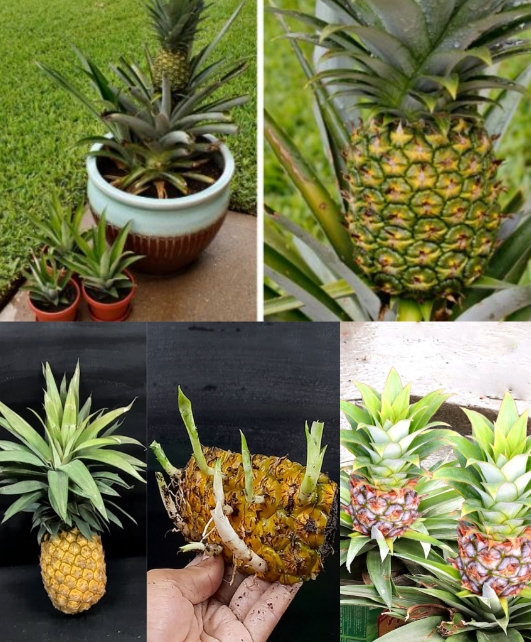Growing pineapples at home is a fun and rewarding project that doesn’t require much space or expertise. With just a store-bought pineapple and some patience, you can grow your own tropical fruit right in your backyard or even indoors. Here’s a step-by-step guide to get started!
1. Selecting the Perfect Pineapple
- Choose a Healthy Fruit: Look for a pineapple with firm, golden-yellow skin and vibrant green leaves on the crown. Avoid fruit with brown or wilted leaves.
- Test Ripeness: A slight sweet fragrance at the base indicates a ripe pineapple, perfect for planting.
2. Preparing the Crown
- Remove the Crown: Hold the leafy crown and twist it off the fruit. Alternatively, use a sharp knife to cut it off.
- Clean the Base: Strip away the bottom leaves (about 1–2 inches) to expose the stem. Remove any remaining fruit flesh, as it can cause rotting.
3. Drying the Crown
- Air Drying: Allow the crown to air dry for 1–2 days. This helps seal the cut and prevents rot when planted.
4. Planting the Crown
- Prepare the Soil: Use a well-draining potting mix with organic matter. A mix of sand, peat, and perlite works well.
- Plant the Crown: Place the dried crown upright in the soil, burying it about 1–2 inches deep. Firmly pack the soil around the base to provide support.
5. Watering and Sunlight
- Watering: Keep the soil moist but not soggy. Overwatering can lead to rot.
- Sunlight: Pineapples love bright, direct sunlight. Place your plant in a sunny spot or near a south-facing window if indoors.
6. Patience and Care
- Growth Timeline: Pineapples grow slowly, so patience is key. New roots and leaves will form within a few weeks.
- Monitor Soil Moisture: Check regularly to ensure the soil doesn’t dry out completely.
7. Feeding the Plant
- Fertilization: Feed your pineapple plant with a balanced fertilizer (10-10-10) every 2–3 months. For a natural option, use compost or diluted fish emulsion.
- Foliar Feeding: Spray a diluted fertilizer solution on the leaves for faster absorption.
8. Transplanting and Space
- When to Transplant: Once the plant outgrows its pot or has developed a strong root system, move it to a larger container or plant it directly in the ground.
- Space Requirements: Pineapples need about 3 feet of space in all directions to grow properly.
9. Harvesting Your Pineapple
- Timeline: Pineapples typically take 18–24 months to produce fruit.
- Signs of Ripeness: The fruit will turn golden-yellow, and you’ll notice a sweet fragrance. Gently tug the fruit—if it comes off easily, it’s ready to harvest.
10. Enjoying Your Homegrown Pineapple
- Celebrate Your Success: Once harvested, slice your pineapple and enjoy its sweet, juicy flavor.
- Get Creative: Use it in smoothies, desserts, or as a refreshing snack.
Pro Tips for Faster Growth
- Warm Environment: Pineapples thrive in temperatures between 65–85°F (18–29°C).
- Mulch: Add a layer of organic mulch to retain soil moisture and regulate temperature.
- Pest Control: Watch for mealybugs or aphids and treat them with neem oil or insecticidal soap.
Why Grow Pineapples at Home?
- Cost-Effective: Save money by growing your own fruit.
- Sustainable: Repurpose a pineapple crown instead of discarding it.
- Tropical Appeal: Add a touch of the tropics to your garden or home decor.
With these easy steps, growing a pineapple at home is both achievable and enjoyable. 🍍 Start today and look forward to the sweet reward of your very own homegrown pineapple! 🌟
💬 Have you tried growing pineapples? Share your tips and experiences in the comments below!
